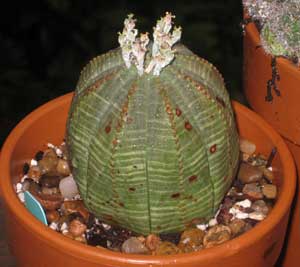Resource Library
Plant of the Week: Sea Urchin Cactus
The University of Arkansas System Division of Agriculture does not promote, support or recommend plants featured in "Plant of the Week." Please consult your local Extension office for plants suitable for your region.
Plant of the Week
Sea Urchin Cactus
Latin: Euphorbia obesa.

I find studying plant form and function endlessly fascinating. With their long history of existence, plants have adapted their structure, habit of growth and physiology in countless ways to survive the rigors of the environmental circumstance where they grow. Frequently, completely unrelated plants will hit upon the same adaptational solution to survive a harsh environment. Evolutionary biologists call this convergent evolution. The sea urchin cactus, Euphorbia obesa is a good example of this phenomenon.
Euphorbia obesa is a tropical member of the spurge family from a very restricted range in the Eastern Cape region of South Africa. It grows as a solid, round, eight-segmented globe typically about the size of a baseball. The gray-green plant body, marked with narrow, transverse, dull purple bands, is unbranched. Like all euphorbias, it has a white, milky sap that can occasionally cause allergic reaction in sensitive individuals.
Small, greenish yellow flowers are produced terminally on older plants. The flowers, though interesting, are not especially showy. As the ball increases in size, the old flower sites leave a round, white scar behind, which eventually forms a series of prominent dots up the center of each of the eight segments.
The common name “sea urchin cactus” illustrates how environmental stress and selection pressures allow convergent evolution to work in nature. This euphorbia grows in a rocky region on steep slopes, where rainfall is typically around 12 inches a year. The small, ball-shaped body – devoid of leaves and branches that would waste precious water – is well-suited to nestle amongst the rocks. Its eight segments allow the plant to shrink up in dry periods and expand when moisture is abundant.
The lookalike plant for Euphorbia obesa is the star cactus from south Texas, Astrophytum asterias. Star cactus is a true cactus that too forms a round, non-thorny, eight-segmented ball occasionally obtaining softball size, with white dots running down each segment. It grows in deserty thorn-scrub land very similar to its African lookalike. The milky sap of the euphorbia and the large showy flowers of the cactus readily separate the two plants when they are closely inspected.
Both of these plants share another trait in common – they have been over-collected to almost complete extinction in the wild. Before the modern ethic of not digging native plants directly from the wild took hold, plant exporters almost destroyed the always-restricted populations of these xeric species. Fortunately, both species have done well in cultivation and are now grown from seed produced by garden-raised plants.
Sea urchin cactus is easy to grow in any well-drained, gravelly soil. Keep plants in small pots and re-pot only when the diameter of the ball reaches the pot rim. Plants are very slow-growing, usually taking 7 years before they attain flowering size. I keep my plant outside on the patio during the summer, where it is watered whenever it rains. In the winter, it is kept dry in my cool, 50-degree greenhouse, watering only in the spring when warmer temperatures return. If carefully tended, plants can attain considerable age.
By: Gerald Klingaman, retired
Retired Extension Horticulturist - Ornamentals
Extension News - August 12, 2011
The University of Arkansas System Division of Agriculture does not maintain lists of retail outlets where these plants can be purchased. Please check your local nursery or other retail outlets to ask about the availability of these plants for your growing area.